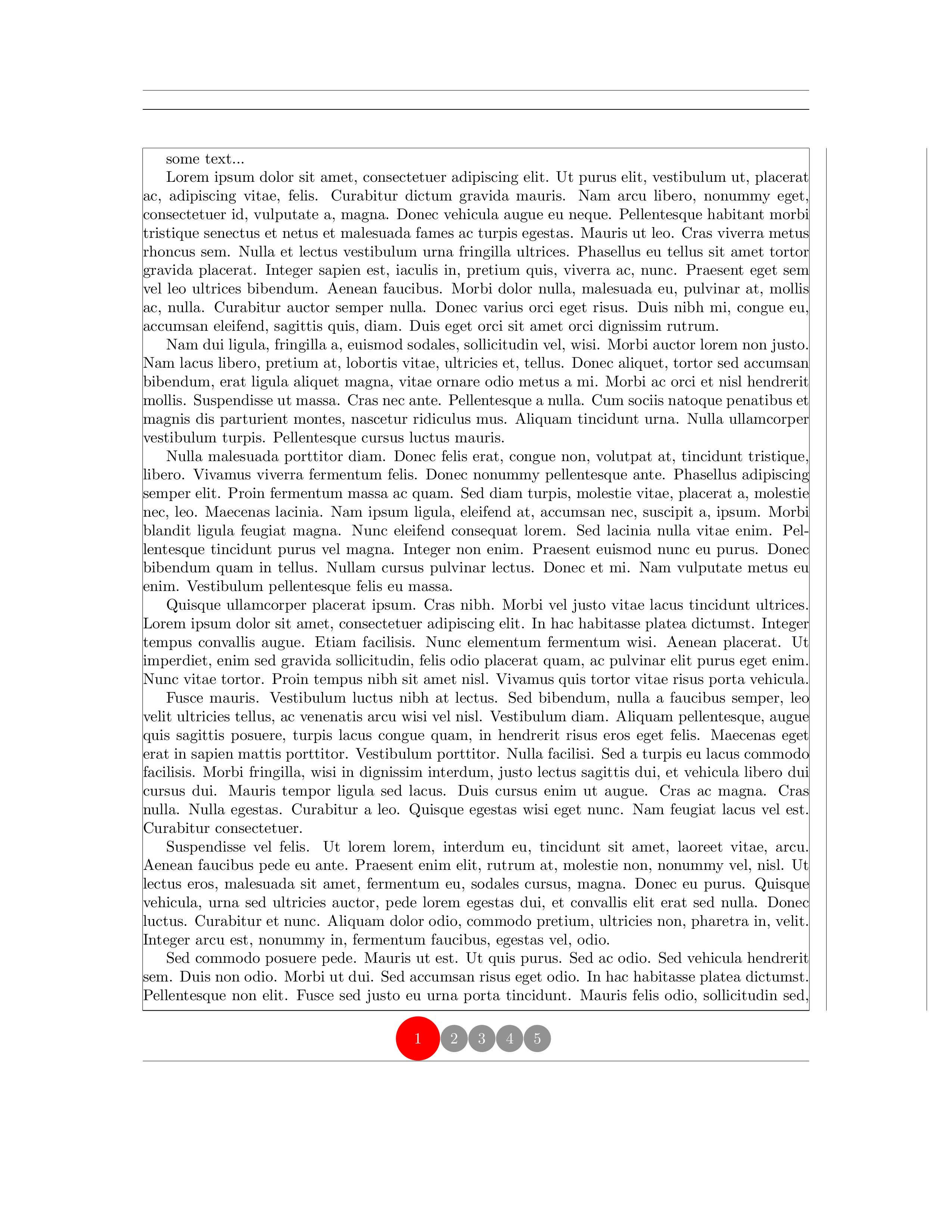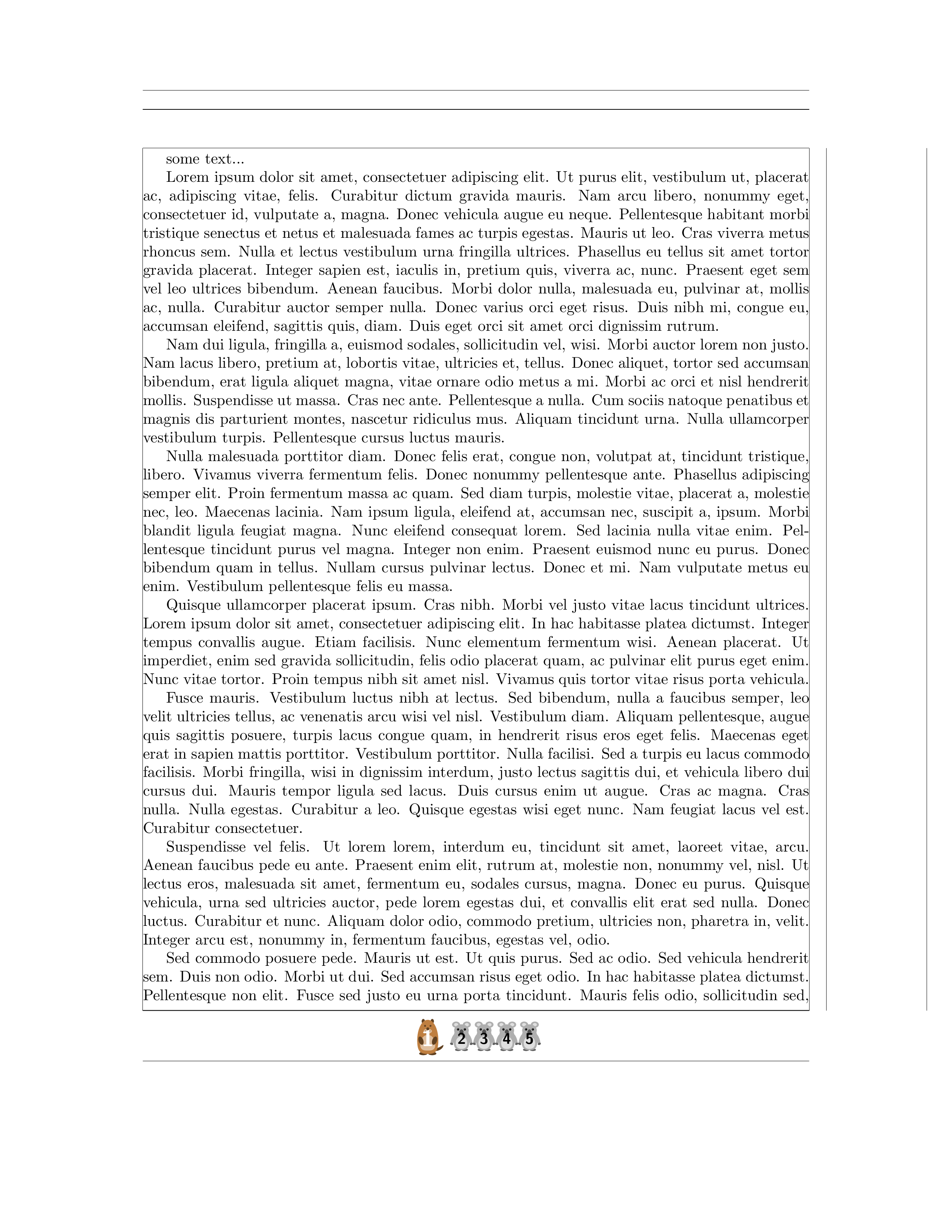
Quero construir uma série de círculos alinhados ombro a ombro em cada rodapé de página. O número de círculos é apenas o número total de páginas, ou seja, cada círculo representa uma página. No centro de cada círculo está o número da página atual.
É fácil conseguir isso \foreachse pgfos diâmetros de todos esses círculos forem iguais. Porém, quero que o círculo que representa a página atual tenha um diâmetro maior.
A composição é como a figura anexa produzida pelo seguinte MWE. Alguém pode me ajudar com isso?
MWE:
\documentclass{article}
\usepackage{fancyhdr,geometry,color,tikz}
\geometry{showframe}
\begin{document}
\pagestyle{fancy}
\fancyhf{}
\renewcommand{\footrulewidth}{0.4pt}
some text...
\cfoot{
\begin{tikzpicture}
\draw[fill=gray,text=white,radius=0.5](0,0)circle node{1};
\draw[fill=red,text=white,radius=1](1.5,0)circle node{2};
\draw[fill=gray,text=white,radius=0.5](3,0)circle node{3};
\end{tikzpicture}
}
\end{document}
Responder1
Algo parecido?
\documentclass{article}
\usepackage{fancyhdr,geometry,lastpage,refcount,lipsum,tikz}
\geometry{showframe}
\usetikzlibrary{positioning}
\begin{document}
\pagestyle{fancy}
\fancyhf{}
\renewcommand{\footrulewidth}{0.4pt}
some text...
\newcounter{lastpagenumber}%
\setcounter{lastpagenumber}{\getrefbykeydefault{LastPage}{page}{1}}%
\cfoot{\begin{tikzpicture}
\coordinate (cn-0);
\foreach \X [remember=\X as \LastX (initially 0)] in {1,...,\thelastpagenumber}
{\ifnum\X=\thepage
\node[circle,fill=red,text=white,minimum size=1cm,right=0pt of cn-\LastX] (cn-\X) {\X};
\else
\node[circle,fill=gray,text=white,minimum size=0.5cm,right=0pt of cn-\LastX] (cn-\X) {\X};
\fi
}
\end{tikzpicture}
}
\lipsum[1-31]
\end{document}
Claro, é possível personalizar a saída de várias maneiras.
\documentclass{article}
\usepackage{fancyhdr,geometry,lastpage,refcount,lipsum,tikz}
\geometry{showframe}
\usetikzlibrary{positioning}
\begin{document}
\pagestyle{fancy}
\fancyhf{}
\renewcommand{\footrulewidth}{0.4pt}
some text...
\newcounter{lastpagenumber}%
\setcounter{lastpagenumber}{\getrefbykeydefault{LastPage}{page}{1}}%
\cfoot{\begin{tikzpicture}
\coordinate (cn-0);
\foreach \X [remember=\X as \LastX (initially 0)] in {1,...,\thelastpagenumber}
{\ifnum\X=\thepage
\node[circle,draw,thick,font=\sffamily\Large\bfseries,fill=red,text=white,minimum size=1cm,right=0pt of cn-\LastX] (cn-\X) {\X};
\else
\node[circle,draw,font=\sffamily\bfseries,fill=gray,text=white,minimum size=0.5cm,right=0pt of cn-\LastX] (cn-\X) {\X};
\fi
}
\end{tikzpicture}
}
\lipsum[1-31]
\end{document}
E se você achar os círculos um pouco chatos, você poderia fazer
\documentclass{article}
\usepackage{fancyhdr,geometry,lastpage,refcount,lipsum,tikzducks,tikzlings}
\geometry{showframe}
\usetikzlibrary{positioning,backgrounds}
\begin{document}
\pagestyle{fancy}
\fancyhf{}
\renewcommand{\footrulewidth}{0.4pt}
some text...
\newcounter{lastpagenumber}%
\setcounter{lastpagenumber}{\getrefbykeydefault{LastPage}{page}{1}}%
\cfoot{\begin{tikzpicture}
\coordinate (cn-0);
\foreach \X [remember=\X as \LastX (initially 0)] in {1,...,\thelastpagenumber}
{\ifnum\X=\thepage
\node[font=\sffamily\Large\bfseries,text=white,minimum size=1cm,right=0pt of cn-\LastX] (cn-\X) {\X};
\begin{scope}[scale=0.4,on background layer,shift={(cn-\X.center)},yshift=-3em]
\marmot
\end{scope}
\else
\node[font=\sffamily\bfseries,text=black,minimum size=0.5cm,right=0pt of cn-\LastX] (cn-\X) {\X};
\begin{scope}[scale=0.3,on background layer,shift={(cn-\X.center)},yshift=-3em]
\koala
\end{scope}
\fi
}
\end{tikzpicture}
}
\lipsum[1-31]
\end{document}






